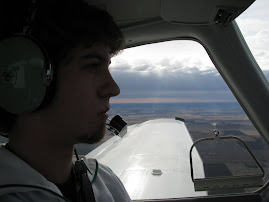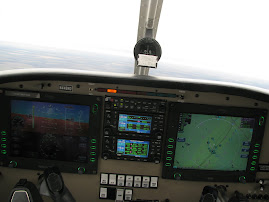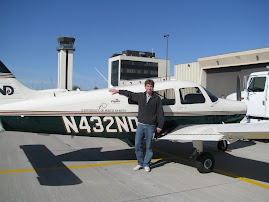A few weeks ago I came upon my Lesson 14 Stage Check. Stage checks for flying are like tests for a classroom. An instructor, different from your own, takes you up to test you on all the flying knowledge gained through the previous 13 lessons. There are two stages to a Stage Check: the oral, and the practical.
When I walked into UND Dispatch to meet my stage check pilot, he seemed ready to get up in the air. When we went to receive our aircraft, he found out he had accidentally doubled up and scheduled two students for a stage check at the exact same launch time. He thought about it for a bit before saying, "It's alright. I'll do you both at the same time." The surrounding instructors got a good laugh from this situation.
The stage check pilot, let's call him Jason, explained to us both how this flight would go with both of us flying. Jason told the other student, we'll call him Bill, to proceed to get the weight and balance and the performance data for our aircraft since he already went through the oral part the previous day. Jason told Bill to continue on to the preflight check as well, and to do it slowly since he still needed to go through the oral part with myself.
When Jason and I finished the oral part of the stage check, we proceeded out to our aircraft only to find Bill just finishing up with the weight and balance and the performance data. At the aircraft, I was assigned to do the interior preflight while Jason and Bill worked together on the exterior preflight. After the preflight was finished, we received our clearance and taxied out to the runway.
This would be my first takeoff with a passenger in the back, but I forgot one crucial part of the flight because I wasn't assigned to it. I forgot to ask Bill for the numbers he got with his calculations. I needed our liftoff speed, the takeoff roll, and the total takeoff distance. Without the rear passenger, the liftoff speed will tend to hover around 48 knots, but with the added weight the liftoff speed will increase as well. The takeoff roll and total distances all depend on the outside air temperature and the wind speed and direction.
I lifted the aircraft off the ground prematurely into ground effect (wingtip vortices are diminished by close proximity to the ground, thereby reducing drag, increasing lift, and increasing performance). I tried to continue climbing but settled back down onto the runway once I flew out of ground effect (roughly the height of the plane's width between the wingtips)...oops. Once I obtained a higher speed I was able to liftoff and continue to climb normally.
Jason announced that it wasn't my fault because it was Bill's job to get the numbers. In reality, I should've remembered to ask Bill for the data and he should have remembered to give it to me had I forgotten. We all screwed up, but we lived.
I proceeded to fly to our destination airport while flying the Aerodynamics Demonstration I needed to perform for Jason. When we arrived at Grafton airport I entered the pattern to to 2 touch'n'goes and one full stop so Bill and I could switch seats. He would fly in the pattern at Grafton as well as the return flight to Grand Forks. The winds, being almost at a direct 15 knot crosswind, didn't make the landings easy. Our PA-28 Piper Warrior is only rated up to a 17 knot direct crosswind. Fortunately, I didn't have to perform any go-arounds.
When Bill and I switched seats, it was my first time sitting in the back with another student pilot at the controls up front. I was interested to see how good of a pilot he was because pilots are constantly judging other pilots and comparing themselves to them. I had my first scare right after takeoff. There are two climb speeds, Vy and Vx. Vy gives the greatest gain of altitude in the shortest amount of time at 79 knots. Vx gives the greatest gain of altitude in the shortest horizontal distance at 63 knots; usually used to clear an object.
Bill was climbing so steeply that we was struggling to maintain 60 knots, let alone 63 or 79! While flying in a traffic pattern, pilots should never bank the aircraft more than 30 degrees because of the amount of lift lost. Bill's first turn was banked closer to 45 degrees than it was to 30! I was definitely on alert, but knew that the airplane wouldn't stall until the wing exceeded the critical angle-of-attack. And Bill was not at those extremes, though he was getting close. Either way, there was a competent instructor up front as well ready to take over at anytime, so I didn't need to worry.
The fun part came when Bill didn't fly far enough away from the airport on the crosswind leg of the traffic pattern. Because of this the downwind leg was close to the airport and only getting closer as he was not compensating for the wind. When it came time for Bill to turn to base, and consequently final, he was way too close to the runway and way too high. He did not extend his final far enough and was approaching the runway at too high of an angle. The glideslope given by the reference lights is usually around a 3 degree slope. Bill was probably closer to 15 or 20 on his first attempt. The plane was 1/3 of the way down the runway and still 30-50 ft in the air when Jason told Bill to execute a go around.
On the second try, Bill still didn't get it. Did I hear the stall warning horn as he climbed out and turned to the crosswind leg? On the third try he was able to land the aircraft, but only after following specific orders from Jason on how to fly the traffic pattern. Throughout this ordeal I was gripping the seat between my legs as tight as I could with both hands and trying to keep a cool expression on my face. I wasn't worried at all about getting sick by how Bill was flying, I was more worried about him possibly crashing the aircraft.
Jason initially told Bill he would perform 2 touch'n'go landings at Grafton, fly back and perform the last landing at Grand Forks. But after the second landing, Jason took control of the aircraft and demonstrated how to fly an excellent traffic pattern and landed the aircraft beautifully with proper wind correction. Bill received one more landing at Grafton to get it down, as I gripped my seat again because he once more had the controls.
Earlier in the flight I pulled the aircraft's nose up to demonstrate those effects, and from that nose-up attitude pitched the aircraft all the way over to a nose-down attitude. During that maneuver we experienced some prolonged negative G-force. During Bill's Aerodynamics Demo I believe he wanted payback on me. He performed abrupt control movements and as he abruptly pitched the nose over I could see Jason's head get thrown back as well as feel my headset brush the top of the cabin. I believe my control movements were smooth, not dangerously abrupt.
Bill is a student pilot just like me, but I hope he just had an off day. Never before had I been legitimately scared while riding in an aircraft. I fully trusted Jason to take over control of the Warrior if need be, but he apparently had more trust in Bill than I did.
The results of the flight were good. Bill and I both passed the checkride, and we came off that flight having both learned something. Bill learned how to fly a better traffic pattern, and I learned never to fly with him again. I expect his flying skills to greatly increase by the time he obtains his Private Pilot certificate, but for now I shall avoid flying with him.
Friday, October 24, 2008
Subscribe to:
Post Comments (Atom)





No comments:
Post a Comment